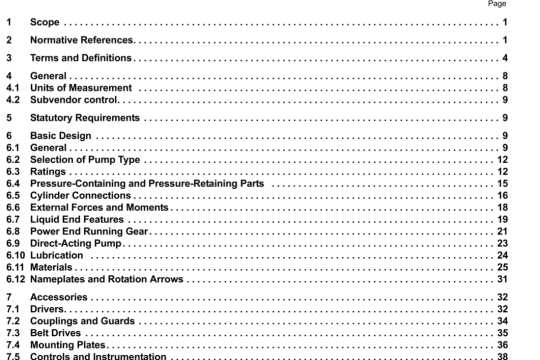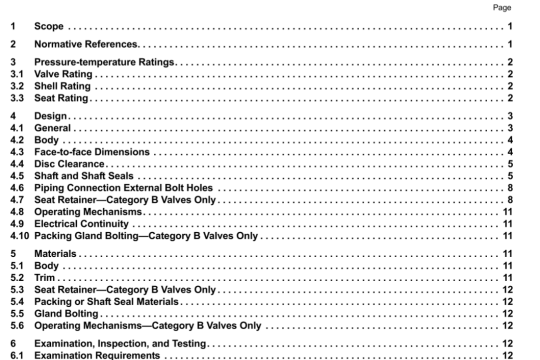API Spec 16F:2004 pdf download
API Spec 16F:2004 pdf download.Specification for Marine Drilling Riser Equipment.
c. Rated load of riser joint.
d. Buoyancy thrust load.
c. Coupling description (manufacturer, model, coupling rated loud).
f. Stress Amplification Factors (SAF).
g. Rated working pressures. burst and collapse (under zero tension).
h. Minimum, working, and maximum temperatures for various riser lin&cornponcnts.
Note: Procedures for determining design loads are deiwled in API RP l6Q. Guidelines for care and operation are also given in API RP 16Q Specifications for coupling design are given in API Spec 16R and ISO 13625.
5.2.1 Size and Coupling Model
Riser systems are categorized by size or the main tube and the .uanutacturer’s coupling model designation. Riser pipe outer diameter, wall thickness, and grade of steel for which the riser system is designed shall be documented. The categorization also includes the characteristics of choke and kill and auxiliary lines (diameters, wall thicknesses, and grades of steel for each).
5.2.2 Rated Load
ii, LIuhy br a parlictibr rated load, neither calculated nor measured stresses in a nser cofliponent in the main tube load path shall exceed the allowable stress limits of the component material when subjected to the rated load. The allowable material stresses are established in Annex B. The load rating of a riser joint may be less than the coupling rating.
Rated loads correspond to the total combined load that may be applied to the component. The total combined load includes the axial tension, bending loads, and pressure separation loads applied to the component. The bending loads shall be combined with the axial tension using the equivalent tension formula given in 5.6. Internal pressure, external pressure, and temperature shall also be considered if they reduce the component’s load rating.
5.2.3 Stress Amplification Factor
The SAF accounts for the increase in the stresses caused by geometric stress amplifiers that occur in riser components. ft is a measure of the fatigue resistance of the component. The calculated SAF values shall be documented at the locations of highest stress and at locations where SAFs are highest. SAF is equal to the local peak alternating stress in a component divided by the nominal alternating stress in the pipe wall at the location of the component. SAF is a function of pipe size and wall thickness. It is calculated as follows:
SAF = Local Peak Alternating Stress
Nominal Alternating Stress in the Pipe
Local Peak Alternating Stress—Highest maximum principal alternating stress in the region of the riser component under consideration. The basic characteristic of a peak stress is that it causes no significant distortion and is only objectionable as a possible cause of fatigue failure These stresses are highly localized and occur at geometric discontinuities
Nominal Alternating Stress—Alternating stress calculated using the nominal pipe wall dimensions of the riser at location of concern.
The SAFs shall he calculated using minimum preload and shall include tolerances for multiple load paths. The SAFs for the bolts of riser components in the primary load path shall also he determined. Since the SAFs may vary with tension, the SAFs shall be determined for a range of tensions up to the rated working load to check for dependence of SAF on load. The SAFs shall be calculated using the stresses obtained for adjacent load increments.
5.2.4 Pressure Ratings
The manufacturer shall document the rated differential pressures (internal and collapse pressures) for the riser system component and the tension conditions for which they apply.
5.2.5 Temperature Criteria
The minimum design temperature for the choke, kill, auxiliary lines, and main tube shall be 32F(0C)unless the purchaserspecifies a lower temperature.The maximum temperatures for design will vary for the different lines. Maximum fluid temperaturefor choke and kill lines and main tube shall be at least 180F(82°C), for both design and working conditions. For al auxiliarylines the maximum temperature shall be at least 135°F(57C).Different combinations of minimum temperatures and workingcondition temperatures in the table below shall be used to determine loads from differential temperatures in various lines.




